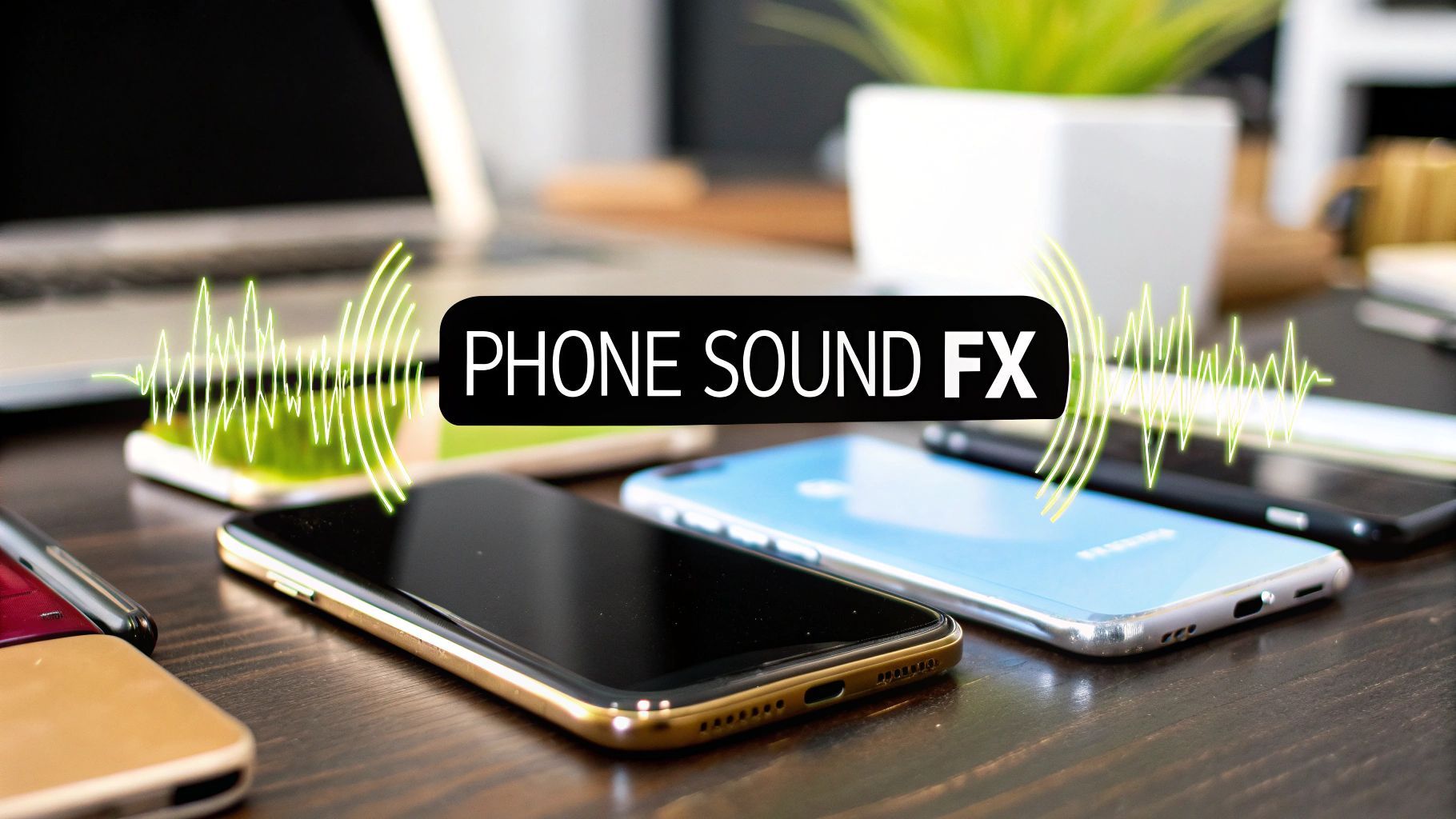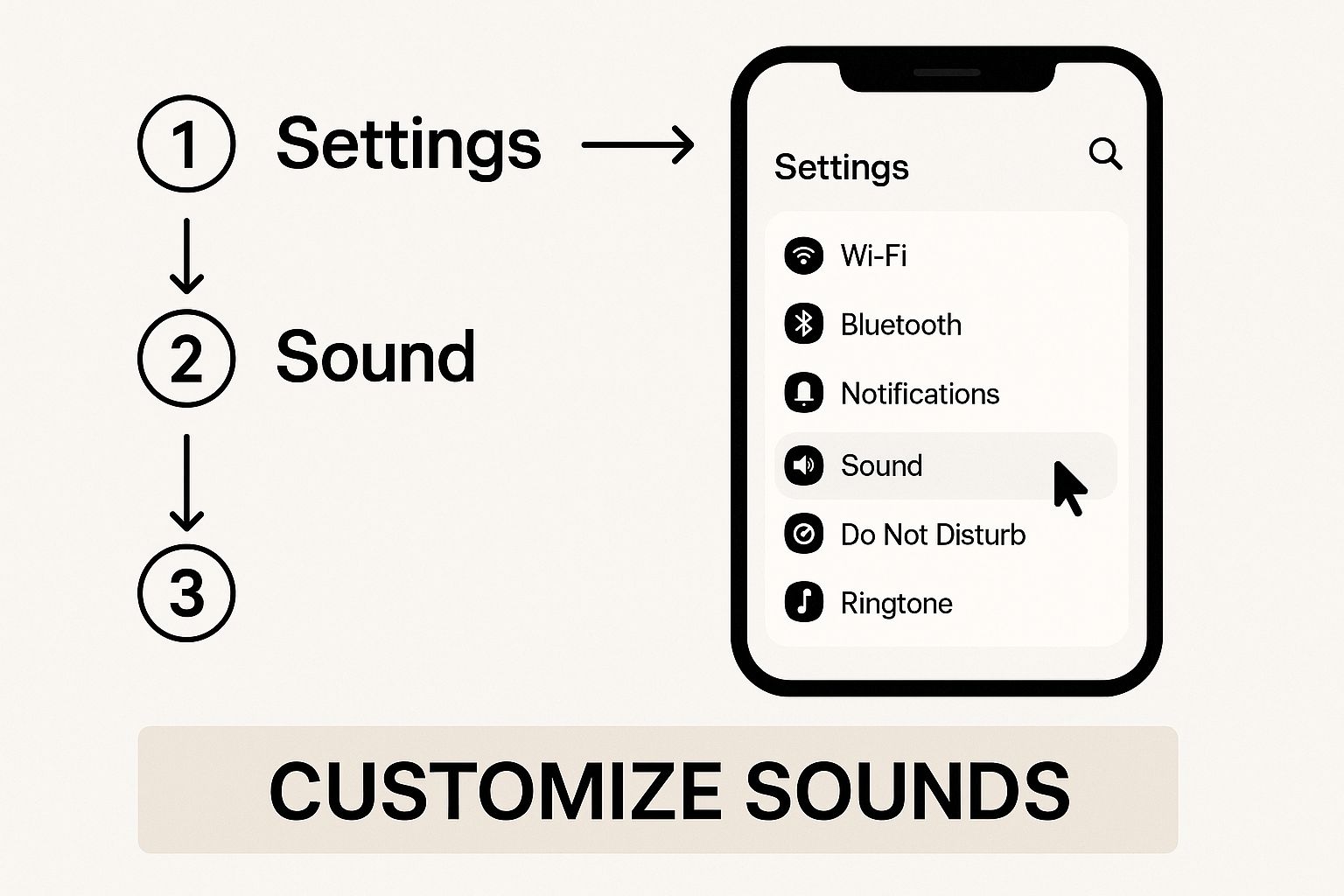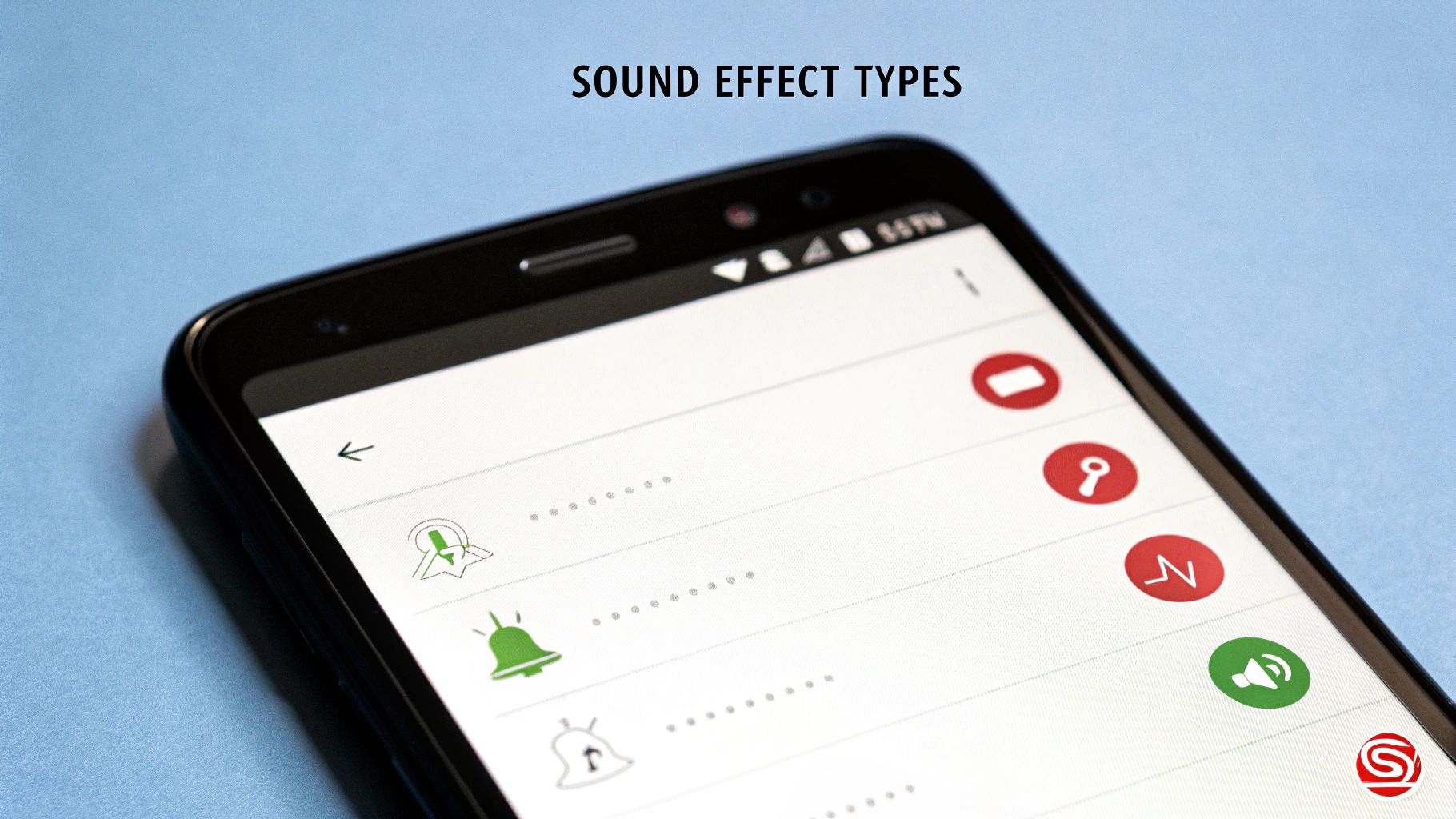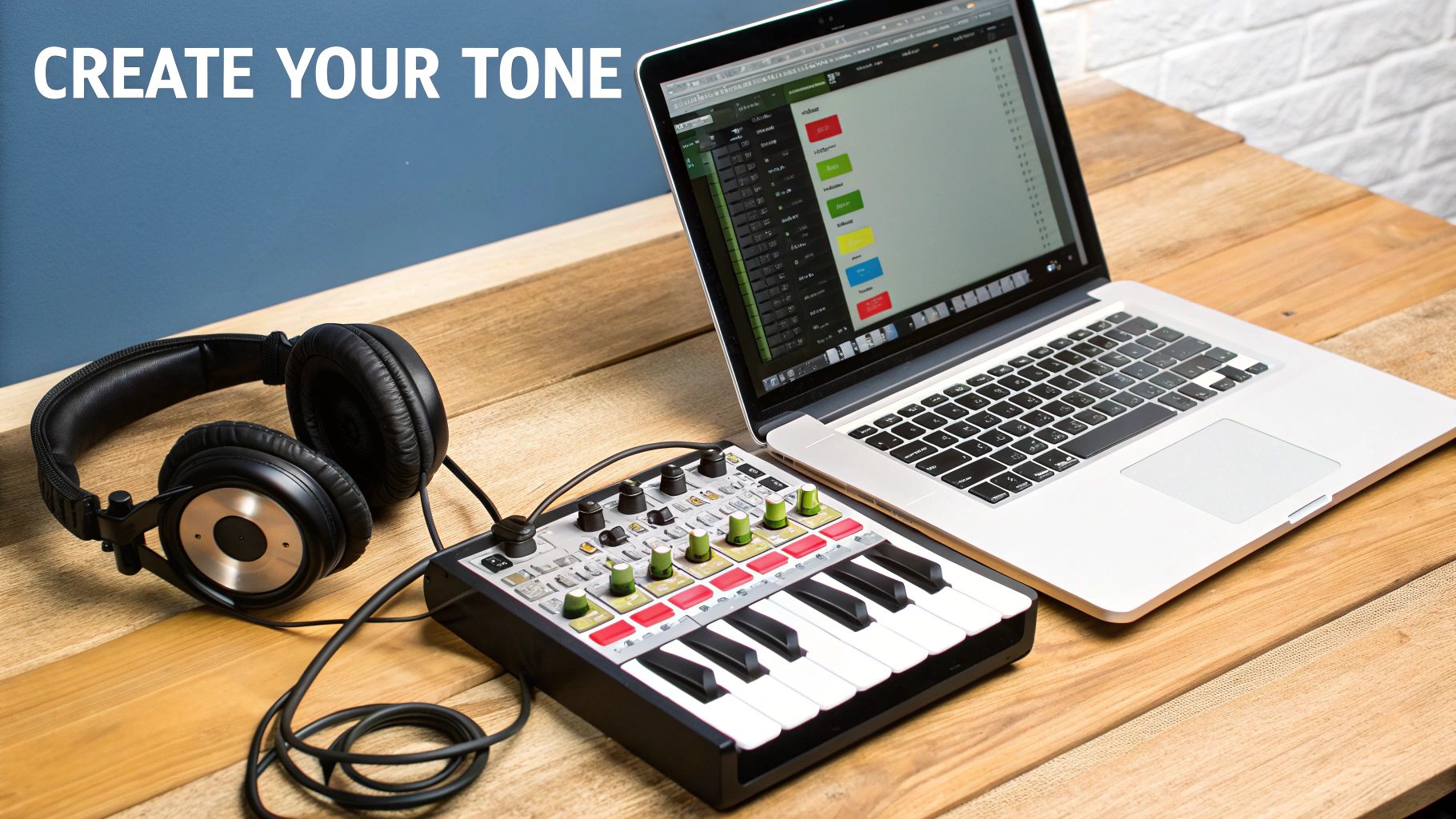
Don't sleep on the little things. Those generic notification beeps and default ringtones you hear everywhere? They're a huge missed opportunity. If you're building a mobile app, producing a film, or designing any kind of media, high-quality phone sound effects are what will set your project apart. These are the tiny audio details that make digital interactions feel real and grounded.
In any project, what you hear is just as important as what you see. It's easy to focus on the big, dramatic sounds—the explosions, the sweeping musical scores—but it's the subtle, everyday noises that truly build a convincing world.
Think about a scene in a movie. A character gets a text, but the sound is a cheesy, stock alert that everyone has heard a million times. It immediately feels fake. That one tiny sound can pull your audience right out of the story you've so carefully built.
Now, imagine the opposite. A custom ringtone that perfectly captures a character's personality. A series of unique UI clicks that make an app feel snappy and satisfying to use. These sounds add a layer of polish and authenticity that people feel, even if they don't consciously notice it.
Getting these sounds right isn't as simple as just downloading a random file. You have to think about the context. Where is the sound happening? What kind of phone is it? What's the emotional tone? This is where a bit of performance artistry comes into play, much like the craft of creating real-world sound effects for film.
The art of recording and performing sounds to match on-screen action is known as Foley. It’s a fascinating field that bridges the gap between sound and storytelling.
You can learn more about this craft by reading up on what Foley sound is and how it brings scenes to life.
This need for high-quality audio isn't just a niche concern. The entire audio industry is shifting, with a growing demand for more immersive experiences, especially on mobile devices. You can see how trends like active noise cancellation are changing user expectations on startus-insights.com.
This is where the magic really begins. We're going to build your unique library of phone sound effects from the ground up. Instead of just grabbing generic presets, we’ll use AI tools to generate a core set of sounds perfectly matched to your project’s vibe. This gives you a powerful foundation to build on.
The secret sauce is all in the prompt. You have to get specific. Forget asking for a simple "notification sound." Think about the world your sound lives in. A prompt like, "A crisp, short, glassy UI notification sound for a minimalist productivity app" is going to give you something infinitely more useful than a vague request. That kind of detail is what separates amateur audio from professional sound design.
It's this demand for custom audio that's fueling massive growth in the sound effects software market, which was already worth around USD 700 million back in 2022. AI-powered tools are a massive driver of this shift, completely changing how creators like us think about sound. You can read more about the sound effects software market growth on verifiedmarketreports.com.
Let's start by generating a few core sounds. These will be your building blocks—the essential elements you can layer, tweak, and modify later on.
To get the best results from your AI tool, you need to feed it the right information. This little cheat sheet should help you get started.
| Sound Effect Type | Suggested AI Prompt | Desired Sonic Characteristic |
|---|---|---|
| Notification Alert | Crisp, short, digital chime with a slight echo | Clean, modern, and unobtrusive |
| Message Sent | Soft, quick "swoosh" followed by a gentle pop | Satisfying, confirms action |
| Swiping Gesture | Smooth, low-frequency whoosh, very subtle | Fluid and barely noticeable |
| Error/Alert | A short, dissonant electronic buzz, not too harsh | Attention-grabbing without being annoying |
| Unlocking Phone | A sharp, clean metallic click | Secure and definitive |
This table is just a starting point, of course. Feel free to play around with different adjectives and descriptions to see what you can create. The more you experiment, the better your results will be.
As the infographic below illustrates, the ability to customize these sounds is at the very heart of a good user experience.

This focus on creating unique, custom sounds is precisely why it's such a vital skill for anyone working on modern digital projects.
Pro Tip: Don't just generate one version of each sound. Always create a few variations. Even tiny differences in pitch, decay, or texture can be a lifesaver in the editing room, giving you options without having to go back to the drawing board.
By starting with these foundational sounds, you'll have a versatile audio toolkit ready in no time. For a deeper look into the creative process, check out our guide on how to make sound effects that bring your projects to life.
An AI-generated sound is really just a blank canvas. The real magic happens in the refinement stage, which is where you take a basic audio file and make it feel like it truly belongs in the scene. This is the step that separates amateur audio from professional sound design.
Think about it: a standard ringtone sounds completely different coming from a phone buried in a backpack versus one sitting on a wooden table. These little details are what make an audience believe what they're hearing. The trick is to picture the context and then use a few simple audio tools to build that reality.
Getting this right is more important than ever. The sound effects software market, which is full of the tools we use for this kind of work, was valued at around USD 14,263.9 million back in 2022 and is only expected to grow. You can discover more about the sound effects software market report on cognitivemarketresearch.com to see just how big this field is getting.

Equalization, or EQ, is your best friend when it comes to placing a sound in a specific environment. It lets you tweak the balance of different audio frequencies, completely changing the sound's character. If you've ever adjusted the bass and treble on a stereo, you've used a basic form of EQ.
Let's say you want to create that muffled effect of a phone ringing from inside a pocket or a purse. Easy. Just grab your EQ and start cutting the high frequencies (the treble). You might even give the low-mid frequencies a slight boost. This perfectly mimics how fabric absorbs those sharp, tinny sounds, leaving you with a much duller, bass-heavy tone.
Key Takeaway: Realism isn't about how clean a sound is, but how accurately it reflects its environment. A muffled, distant ringtone is often more believable than a crystal-clear one.
Next up, you have to think about the room itself. A notification ping in a small, carpeted bedroom is going to sound way different than one echoing through a cavernous, empty warehouse. That's where reverb comes into play.
Sometimes, one sound just won’t cut it. By layering multiple sounds on top of each other, you can create something far richer and more interesting. This technique is especially great for UI interactions, like app notifications or button clicks.
For example, a really satisfying "message sent" sound might actually be three separate sounds combined:
When you blend these simple elements and play with their timing and volume, you end up with a phone sound effect that feels incredibly polished and intentional. This is a core technique that pros use all the time.
Alright, so you’ve spent the time crafting the perfect phone sound. Now for the fun part: actually putting it to work. Getting a great sound is one thing, but how you weave it into your project is where the real magic happens. This is the moment your technical work blends with pure creative instinct.

How you do this really depends on what you're making. For filmmakers, it’s all about story and emotion. That perfectly timed notification ping can be the punchline to a joke, a sudden jump scare, or the signal that a character's world is about to change. You’re not just dropping in a sound; you're making it part of the performance.
For game designers, it’s a whole different ballgame. Phone sounds are often part of the feedback loop, telling a player they’ve succeeded at something or that time is running out. The trick is to make these sounds feel like a natural part of the game world, not just an audio file playing on top of it.
When it comes to video, timing is king. Nothing sells a moment like syncing a custom text alert with an actor’s reaction. The goal is to make the sound and the visual feel so connected that the audience doesn't even think about them as separate elements.
Picture this: in a tense scene, a character's phone vibrates on a wooden table. That sound needs to hit the exact moment the actor’s eyes flick down to it. If it’s even a hair off, the entire illusion crumbles. This takes a bit of patience in the editing timeline, nudging that audio clip frame by frame until it just feels right. We've got a whole guide with more tips on sound effects for editing videos if you want to dive deeper.
I see this all the time: a crisp, clean phone ring is used for a character standing across a busy street. Don't forget to apply those environmental effects! A little EQ and reverb to match the on-screen location make all the difference.
For interactive projects, phone sounds are a core piece of the user experience. They have to be helpful and satisfying, but you have to be careful they don't get annoying after the hundredth time hearing them. A smart way to handle this is to tie the sound directly to what the player is doing.
Think about a "low battery" warning in a mobile game. A single, obnoxious alert is one way to go, but it's not very elegant. Instead, you could have a subtle, intermittent sound that gets more frequent as the power level drops. This approach builds tension and informs the player without yanking them out of the experience.
Here’s how the goals break down for each medium:
| Medium | Primary Goal | Key Consideration |
|---|---|---|
| Film/Video | Enhance Narrative | Perfect synchronization with on-screen action |
| Games/Apps | Provide Feedback | Clarity and responsiveness without being irritating |
Once you've nailed the basics, the real fun begins. This is where you move past simply generating assets and start creatively shaping them to build a project’s unique sonic identity. You'd be surprised how a single notification alert can be the source for dozens of distinct phone sound effects.
One of the most effective tools in your arsenal is pitch modulation. A slight adjustment up or down can create a whole family of related but different alerts. This is a fantastic trick for app UIs, where you need separate sounds for a new message, a friend request, and a calendar reminder that all feel like they belong together.
Think beyond the individual sounds and consider the personality of the device itself. Is it a sleek, futuristic phone in a sci-fi film? Its sounds should match—glassy, ethereal chimes and smooth, subtle swooshes. On the other hand, an old, beat-up phone for a character down on their luck might have glitchy, distorted, or slightly laggy sound effects that help tell their story.
This is where you start thinking like a true sound designer. Ask yourself a few key questions to guide your choices:
For that extra layer of realism, try blending your generated tones with real-world Foley. A clean, digital notification sound is good, but when you layer it with the actual recording of a phone vibrating on a wooden desk, it suddenly has a tangible, physical quality.
A while back, I was working on a project and needed a convincing low-battery alert. I took a generated tone and mixed it with a recording of my own phone's speaker crackling. The result was a sound that felt genuinely broken and desperate, which perfectly amplified the tension in the scene.
This fusion of the digital and the physical is what elevates your work. It’s how you create unique phone sound effects that not only sound real but also add genuine character and depth to your project. These small, thoughtful details are what make your audio truly memorable.
When you're deep in a project, you start to notice the same little problems crop up again and again with phone sounds. Let's talk about a few of the most common ones I see.
One of the biggest hurdles is getting the sound to feel like it actually belongs in the scene. It’s a common trap, especially in film. You grab a perfectly clean, studio-recorded ringtone, drop it into your mix, and it just...sticks out. It sounds fake because it's too perfect for the environment.
Then there's the technical side of things. People often ask about file formats and specs. Every platform—whether it’s a game engine, a mobile app, or a video editor—has its own quirks. Pick the wrong format, and you could end up with playback glitches or a project file that's way bigger than it needs to be.
I can't tell you how many times I've seen projects bloated by uncompressed audio. A high-quality .WAV file is fantastic when you're in the editing phase, but for the final product in a mobile app or game, a compressed format like .OGG or .MP3 is almost always the smarter choice. It's all about balancing quality with performance.
The sweet spot is creating audio that just melts into the background. It needs to support the story and the visuals without screaming, "Hey, listen to me! I'm a sound effect!"
This is a big one. When you're designing sounds for a user interface, your job is to give helpful feedback, not create a cacophony. The sound needs to instantly confirm an action—a message sent, a file deleted—without becoming grating after the hundredth time someone hears it.
Here’s what I focus on to get it right:
At the end of the day, good UI sound design is all about function. Every single sound should have a purpose. If it doesn't add value or make the interface clearer, you're probably better off leaving it out.
Tired of endlessly scrolling through generic sound libraries? With SFX Engine, you can generate unlimited, high-quality, and royalty-free phone sound effects that are built specifically for your project. Start creating for free today at SFX Engine.